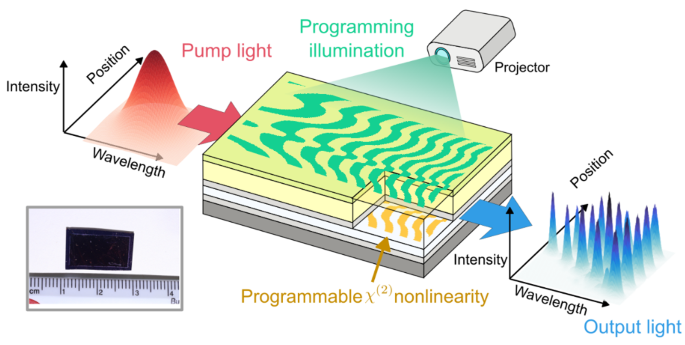NTT Research, Inc., a division of NTT, announced that its Physics and Informatics (PHI) Lab, working with Cornell University and Stanford University, has developed the world's first programmable nonlinear photonic waveguide that can switch between multiple nonlinear-optical functions on a single chip. The breakthrough fundamentally alters how nonlinear photonic devices operate, breaking the “one device, one function” paradigm, and significantly expands the applications for tunable light sources, optical and quantum computation, and communication.
 Figure 1. Diagram of a proof-of-concept programmable nonlinear channel waveguide fabricated by NTT Research, Cornell and Stanford scientists. Inset: Image of the device. Image Credit: NTT Research
Figure 1. Diagram of a proof-of-concept programmable nonlinear channel waveguide fabricated by NTT Research, Cornell and Stanford scientists. Inset: Image of the device. Image Credit: NTT Research
Ryotatsu Yanagimoto, a scientist at NTT Research, led the research under the supervision of Peter L. McMahon, an associate professor at Cornell University. The paper, “Programmable On-Chip Nonlinear Photonics,” was published by leading scientific journal Nature online on Oct. 8, 2025. It will be published in print by Nature on Nov. 13, 2025.
“These results mark a departure from the conventional paradigm of nonlinear optics, where device functions are permanently fixed during fabrications. This expands applications of nonlinear photonics to situations in which fast device reconfigurability and high yields are not merely convenient but essential,” said Yanagimoto. “For the first time, a path forward has been created to apply nonlinear optics to large-scale optical circuits, reconfigurable quantum frequency conversion, arbitrary optical waveform synthesizers and widely tunable classical and quantum light sources—all of which are vital to enabling advanced computing and communications infrastructure.”
Breaking the Traditional Photonic Device Model
Conventionally, photonic devices follow a "one device, one function" paradigm, meaning each optical component can only perform a single, predetermined task that is fixed during the device fabrication. This limitation requires manufacturers to create separate devices for different functions, increasing costs and complexity while reducing manufacturing yields due to fabrication errors.
The programmable nonlinear waveguide developed by NTT Research and its collaborators (Figure 1), however, uses a silicon nitride core whose nonlinearity can be dynamically modified using structured light patterns. When a structured programing light is projected onto the device, it creates specific patterns of optical nonlinearity that determine the device's function. Different light patterns enable different nonlinear-optical functions, all on the same physical chip, in a rapidly reconfigurable manner.
Using this new device, researchers successfully demonstrated arbitrary pulse shaping, widely tunable second-harmonic generation, holographic generation of spatio-spectrally structured light and real-time inverse design of nonlinear-optical functions in a way that is robust against fabrication errors and environmental drifts.
For an analysis of this experiment and its results, please read the blog post written by Yanagimoto, “Demonstrating Programmable, On-Chip Nonlinear Photonics Transcending the One-Device-One-Function Paradigm.”
Cross-Industry Impact of Advanced Photonic Technologies
According to IDTechEx, the photonic-integrated circuit technology market is projected to experience significant growth over the next decade to over $50 billion in revenue by 2035 (across markets including datacoms, 5G telecoms, quantum, sensors and LiDAR).
The technologies developed in this work could address several major obstacles faced by the photonics industry as compared to conventional approaches, such as:
-
Cost Reduction: Instead of manufacturing multiple specialized devices, companies can produce a single programmable chip that performs many functions, potentially reducing R&D and production costs by orders of magnitude.
-
Improved Yields: The ability to program functionality after fabrication means devices can be corrected for manufacturing imperfections, dramatically improving production yields. This is essential for building a large-scale optical circuit, where the requirement for yields is exponentially stringent.
- Space and Power Efficiency: Single devices performing multiple functions reduce the footprint and complexity of optical systems.
This technology shows particular promise in several high-growth markets, including quantum computing, as programmable quantum frequency converters and quantum light sources could enable more flexible computational architectures and improved quantum networking capabilities. In telecommunications, widely tunable light sources and arbitrary waveform generators could enhance 5G and 6G infrastructure and optical communication systems.
Other practical use cases include advanced manufacturing and imaging, in which programmable, structured light sources could enable greater precision and adaptability. Additionally, scientific instrumentation could benefit as real-time reconfigurable optical systems may improve laboratory equipment and measurement devices.
Looking Ahead
There are several possible directions that this work could evolve into. First, the techniques developed in this work could be used to “augment” programmable nonlinearities across a wide range of existing photonic devices, engineering emergent functions by leveraging their interplay with the original functions. Second, this work leveraged a relatively unexplored physical effect—electric-field-induced nonlinearities—to realize programmable nonlinearity, but its full potential remains unknown; further materials exploration on this front could significantly expand the scope of this technology. Finally, the demonstrations in the present work were limited to classical nonlinear-optical functions. A demonstration of programmable quantum functions would have significant impact on the field.
The NTT Research PHI Lab is dedicated to the study of computation within the fundamental principles of quantum physics and brain science while simultaneously developing both hardware and software. This work showed that nonlinear photonics could become much more scalable, flexible and programmable than what we used to think.